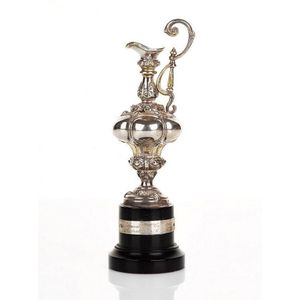Sea Green Glass Ewer by James Powell & Sons
You must be a subscriber, and be logged in to view price and dealer details.
Subscribe Now to view actual auction price for this item
When you subscribe, you have the option of setting the currency in which to display prices to $Au, $US, $NZ or Stg.
- Knop (glass) - In Georgian glassware, the knop is a bulbous protrusion, usually midway up the stem of the glass. It may be included singly or in groups, and may be hollow or solid. There are many styles of knop including basal, baluster, bell, acorn, cone, flattened, melon and mushroom.
- Baluster (glass) - An architectural term for a column in a balustrade or staircase.
When used to describe glass, it can either refer to the shape of the stem of a wine glass, being slender above and pear shaped below, or the shape of the whole vessel, usually a vase. In fact the baluster shape is often described as being vase-like.
The description of a vase as being of baluster shape covers a wide variety of shapes that often bear no resemblance to the original architectural form. - Ewer / Pitcher - A type of jug with a narrow neck bulbous body and wide spout, originally used for carrying and storing liquids such as water or wine. In medieval times they were the source of water to wash ones hands during and after a meal. later the shape was used for vessels in silver, gold, glass and ceramics.
In Victorian times they were made in ceramics and occasionally glass with a matching basin, and sometimes other accessories such as a soap holder or toothbrush holder. Their purpose was to provide facilities for personal washing In the early 19th century were often enclosed in purpose built stands, and later resided on a washstand..
Sometimes the words "ewer" and "pitcher" are used interchangably, but a pitcher is generally considered to be a jug, and would have a wide mouth, and a gently tapering body. - Art and Crafts Movement - The Arts and Crafts movement began in Britain around 1880 and quickly spread across America and Europe. The Movement took its name from the Arts and Crafts Exhibition Society, founded in London 1887. One of the most influential figures behind the Arts and Crafts movements was the designer and writer William Morris. The movement continued until about 1920 and was followed by the Art Deco movement.
This item has been included into following indexes:
Visually similar items

A Barossa Valley wardrobe with three drawers, unusual bobbin turned columns and flame cedar doors, 19th century, 220 cm high, 138 cm wide, 44 cm deep

Royal Doulton figurine - The Orange Lady, HN1759, in production 1936 - 1975, 22 cm high

Silver miniature trophy engraved ' America's cup 1983 Australia II R. P. Y. C.', English hallmarks. Height 19 cm

A Chinese Nonya wear jacket, late Qing Dynasty, embroidered, woven and appliqued, the buttons very finely worked
